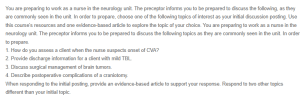Surgical Management of Brain Tumors
Preoperative Preparation
The surgical management of brain tumors is a complex and critical aspect of neurological care, aiming to remove or reduce the size of the tumor while preserving neurological function. The primary objective of surgery is to achieve maximal safe resection, which involves excising as much of the tumor as possible without causing significant damage to surrounding brain tissue (Sales et al., 2022). Preoperative preparation is crucial for successful surgical outcomes. It includes a thorough assessment of the patient’s medical history, neurological status, and imaging studies such as MRI or CT scans. Functional MRI or intraoperative brain mapping may also be utilized to identify and preserve critical brain areas responsible for speech, motor, and sensory functions (Aiman & Rayi, 2021).
Intraoperative Techniques
During surgery, advanced techniques such as neuronavigation, intraoperative MRI, and awake craniotomy are employed to enhance precision. Neuronavigation systems provide real-time guidance based on preoperative imaging, allowing surgeons to navigate accurately within the brain (Chicoine et al., 2020). Intraoperative MRI can be used to assess the extent of tumor resection during the procedure, enabling immediate adjustments if necessary. Awake craniotomy is particularly beneficial for tumors located near eloquent brain areas, as it allows continuous monitoring of the patient’s neurological function.
Postoperative Care
Postoperative care involves close monitoring in the intensive care unit (ICU) to detect and manage potential complications such as cerebral edema, infection, and hemorrhage. Rehabilitation therapies, including physical, occupational, and speech therapy, are often necessary to address any deficits and improve the patient’s functional outcomes (Nehring et al., 2019).
Conclusion
In conclusion, the surgical management of brain tumors involves meticulous planning, advanced intraoperative techniques, and comprehensive postoperative care to achieve the best possible outcomes for patients.
References
Aiman, W., & Rayi, A. (2021). Low-grade gliomas. PubMed; StatPearls Publishing. https://www.ncbi.nlm.nih.gov/books/NBK560668/
Chicoine, M. R., Sylvester, P., Yahanda, A. T., & Shah, A. (2020). Image guidance in cranial neurosurgery. Missouri Medicine, 117(1), 39–44. https://www.ncbi.nlm.nih.gov/pmc/articles/PMC7023946/
Nehring, S. M., Tadi, P., & Tenny, S. (2019, March 25). Cerebral edema. Nih.gov; StatPearls Publishing. https://www.ncbi.nlm.nih.gov/books/NBK537272/
Sales, A. H. A., Beck, J., Schnell, O., Fung, C., Meyer, B., & Gempt, J. (2022). Surgical treatment of glioblastoma: State-of-the-art and future trends. Journal of Clinical Medicine, 11(18), 5354. https://doi.org/10.3390/jcm11185354
ORDER A PLAGIARISM-FREE PAPER HERE
We’ll write everything from scratch
Question
You are preparing to work as a nurse in the neurology unit. The preceptor informs you to be prepared to discuss the following, as they are commonly seen in the unit. In order to prepare, choose one of the following topics of interest as your initial discussion posting. Use this course’s resources and one evidence-based article to explore the topic of your choice. You are preparing to work as a nurse in the neurology unit. The preceptor informs you to be prepared to discuss the following topics as they are commonly seen in the unit. In order to prepare.

Surgical Management of Brain Tumors
1. How do you assess a client when the nurse suspects onset of CVA?
2. Provide discharge information for a client with mild TBL.
3. Discuss surgical management of brain tumors.
4. Describe postoperative complications of a craniotomy.
When responding to the initial posting, provide an evidence-based article to support your response. Respond to two other topics different than your initial topic.

